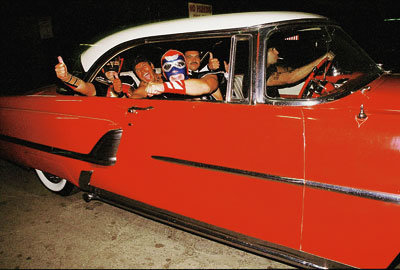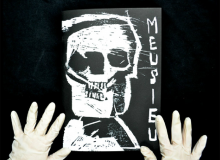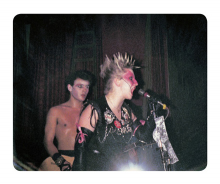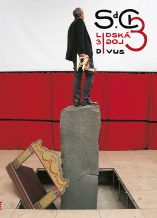| Umělec magazine 2007/2 >> LUCHA LIBRE - Professional wrestling - More real than reality | List of all editions. | ||||||||||||
|
|||||||||||||
LUCHA LIBRE - Professional wrestling - More real than realityUmělec magazine 2007/201.02.2007 Héctor Villarreal | wrestling | en cs de es |
|||||||||||||
|
What is Professional Wrestling?
Publicists often describe it as a spectacle-sport. Anthropologists may speak of it as a mythic drama between the forces of good and evil, where the values of society are played out by heroes and villains, who sometimes even double as cultural idols. Political scientists would perhaps remind us of the words of the Roman poet Juvenal, who criticized the masses for limiting their hopes to “bread and circuses.” Professional wrestling is prefabricated alienation, a mechanism of ideological control, such as soccer, soap operas, or pop music. Sociologists would remind us that spectators, the majority of them belonging to the working and lower classes, go to the arena to escape drudgery and oppressive economic/social conditions. Market research reveals that professional wrestling is a multimillion-dollar form of televised live entertainment that is targeted specifically at lower-income consumers. And finally, the educated middle classes are inclined to dismiss it all as a farce that fools only the illiterate; as trash; just another example of so many expressions of bad taste. One way or another, everybody is right: professional wrestling is all of the above, and more. Professional wrestling takes place in and around a raised square platform with corner posts connected by ropes, a cousin to the boxing ring. It is a contact sport in which locks, holds, and maneuvers typical of Judo and Greco-Roman wrestling, are used, although blows with the hands, head, and feet are also allowed. The way that professional wrestlers take advantage of the ropes, to launch themselves or their rivals across the ring or into the air, is unique to the sport. Wrestlers can win by pinfall or submission. Pinfall occurs when one wrestler is able to pin the shoulders of an opponent to the mat for three counts; submission is when the opponent surrenders. In Mexico, a match is determined by two out of three falls, whereas, in the United States, only one is required. Individuals can fight each individually, as well in pairs, trios, or quartets of different weights. Men and women are divided into two categories, and in Mexico there is still a third, in which midgets, or little people, are pitted against one another. What characterizes Lucha Libre? The first Mexican company devoted to this popular form of entertainment, The World Council of Professional Wrestling (CMLL, from its name in Spanish,) was founded on the 21st of September, 1933, by Salvador Lutteroth. He also acquired the stadium which has become one of the principal homes to Lucha Libre (literally, Free Wrestling), the appropriately named Arena Mexico. As the CMLL website tells us (http://www.cmll.com), professional wrestling came to Mexico from Europe. Its roots go back as far as 1863, when the French Army occupied Mexico. And with certainty, it is known that, in 1910, the companies of the Italian champion Giovanni Relesevitch and of Antonio Fournier came to Mexico, “bringing among their stars the famous Count Koma and Nabutaka. The rivalry between the two companies constituted a splendid business.” Later, in 1921, Constand le Marin arrived “promoting, with his company, Navarro the Lion, a former middle-weight champion in Europe.” The Romanian wrestler Sond, among others, also came to Mexico. And two years later, le Marin brought the Japanese Kawamula, along with Hercules Sampson. Foreign wrestlers, from Europe, Japan, and the United States, have always been important to Mexican wrestling, whether they make a single appearance, stay for a season, or move to Mexico permanently. Wrestling fans like to see their idols win battles of epic proportions, overcome insurmountable odds, or otherwise empirically prove the superiority of Mexicans by beating the representatives of powerful nations. In 1984, for example, Canek (named after the Mayan Prince) defeated the Frenchman Andre the Giant- almost 450 pounds, over 7 feet tall- a hunk of a man. The fans attribute such victories to “Mexican ingenuity,” cleverness, or the fact that Mexicans fight with “a whole lot of heart.” Today, there is a group of foreign heels who call themselves The Foreign Legion, and among faces there is the Italian Marco Corleone, and the Russian Alex Koslov. In Mexico, heels are called “roughs” and faces “technicians.” As in the United States, wrestlers belong to either of two distinct groups, to the heroic faces, or the villainous heels. Each wrestler must decide which group he or she belongs to, and must remain congruent with its distinctive ethic (to be explained below). Distinctively Mexican, however, is that many wrestlers in Lucha Libre wear a mask that covers not only their faces but their identities, too. Wrestlers are not known by their real names, as in boxing, but by that of their chosen persona. The first wrestler to wear a mask in Mexico, The Masked One, first did so in 1934. Since then, masks have functioned in Lucha Libre with a status similar to magical objects. They are the most valued possession that a wrestler has, revered and admired by fans, many of whom wear the mask of their idol while watching a match, one that can be purchased in the very same arena where the match takes place. A mask is an icon, one element of a symbolic universe, a collective imagining. But the mask has also had another function: it has allowed company owners and promoters to have “one” wrestler simultaneously appear in two or more separate arenas, a successful strategy in a country with poor communication and impassable landscapes. In this sense, wrestling folklore is also just business. Rivalries between the biggest wrestlers lead to the most important bouts, the ones in which the masks of wrestlers are gambled. In these the loser is humiliated, his mask taken off in front of everyone and given to the winner. He is forced to reveal his real name and can never put on his mask again. Mask-vs.-mask battles usually turn out to be especially bloody, because the wrestlers attempt to tear off each other’s masks in order to bite their rival’s forehead, or else to hurt them with some foreign object. When a wrestler is without a mask, either because it has been lost in a match, or because one was never worn at all, they must bet their hair. In these cases, if they lose, their head is sheared in front of the whole auditorium. Besides mask-vs.-mask showdowns, then, there are also the equally bloody categories of mask-vs.-hair and hair-vs.-hair. The greatest wrestlers, the most idolized, are those who remain undefeated in these gambling matches, those who are able to retire as professionals, preserving their masks and their names to pass on to a successor who will continue to defend and wrestle with them. Very few, however, have achieved such success. Is professional wrestling for real? The conclusion that wrestling matches are rigged can be drawn simply by realizing that there are holds, locks, and other maneuvers that could not be made without the complicit participation of opponents. Some moves that appear ghastly are in fact nearly painless. Others would cause grave injury, injury much greater than they apparently inflict, if they were to be performed with all the strength and weight of the one affecting them. Many fans and spectators watching the matches, either in the arena or on television, recognize that professional wrestling is much like theater, or magic shows; but even so they enjoy it. It is like The Matrix. For them, reality is that we live in a stable and eat worms, fiction that we could eat steak in a gourmet restaurant. It all depends on your attitude. You could be bitter and say “not only does my life suck, but they want to fool me with wrestling.” You could reason, analyze every move, and discover the trickery in it all. Or, you could feel that “life is not so bad, wrestling makes it more bearable.” That is why, in Mexico, those who eat in fancy restaurants are not likely to be “duped,” to believe in the truth of wrestling. They will insist that it is merely simulacra. Andrew Darley (2003: 85), when explaining the differences among types of entertainment, affirms that popular forms are based in “visual modes of representation engineered to stimulate the eye’s curiosity, to excite and amaze the spectator.” Entertainment “befitting of the ruling classes,” on the other hand, stresses “the coherence of the plot and the credibility of a fictional universe.” But, leaving the restaurant-steak-eaters aside for a moment, isn’t it true that, for most Mexicans, everything already appears to be a sham anyway? Why is Lucha Libre so successful in Mexico? Just like in most Hollywood films or soap operas, the audience knows how things will end beforehand –that is, the bad character will lose, and the good one will win and marry the beautiful girl- and yet, nobody leaves the movie theater or turns off the television set. The audience of Lucha Libre enjoys, again and again, the staging of a story whose ending it already knows, or anticipates. Wrestling has a coded narrative structure just like the ones in other cultural productions. It is simple, widely recognized by a large cross-section of the population, easily and quickly understood, and presented in an enjoyable fashion (Da Tavola, 1991: 13). This allows the average fan, who perhaps has little schooling and is not particularly versed in the canons of so-called high culture, to understand immediately the well-rehearsed plot. Such a fan is not necessarily asking for originality, just good performances. Every match is more or less predictable. The face–the good guy, a hero- endures and usually prevails by overcoming adversity and the treachery of his opponent. Contrarily, the heel – the bad guy, a villain- can win only by tricks, cheating, or by taking advantage of the actions of a third party that are ultimately to the detriment of his opponent. As explained by the sociologists Elias and Dunning (1992:92-103) with regard to the search for excitement and leisure, wrestling provides an occasion where one can “experiment the overflowing of strong emotions in public” without endangering or calling into question the social order. Through mimesis, one can experience real life emotions such as fear, compassion, or hate in a pleasurable way, because they “do not imply any social or personal danger and rather provide a cathartic release.” Clearly the arena is a space of catharsis. It is one of the few places where poor people can insult those more powerful, stronger, or important than themselves until they are red in the face—without suffering any retaliations or repercussions. Generally, it is they that find themselves mistreated or the objects of contempt. In Mexico, for example, the law favors the rights of the motorist over and above those of the pedestrian. What makes wrestling a social phenomenon? To a large extent, the importance of Lucha Libre in the collective popular imagination is the result of it being continually reproduced by the national cultural industries. Due to its narrative qualities, Lucha Libre has been, in years past, a successful theme in comic books, movies, and other media. Wrestlers have had their lives outside of the ring fictionalized, thus extending their roles as heroes or villains. This is how El Santo, the man masked in silver, became the greatest wrestler of all time in the history of Lucha Libre: not just because of his exploits in the ring, but due to those on the big screen, as well. He starred in no less than fifty motion pictures between 1952 and 1973. Thanks to these movies, El Santo came to embody qualities not only heroic, but also the more saintly ones suggested by his name. He was chaste, sacrificing, modest, wise, courageous, strong, kind, and honorable, among many other things. With these qualities, and a nascent modernity inspired by James Bond- communicating wrist watches and shiny box cartons with blinking little lights, he defeated all kinds of threats to humanity—whether criminal, diabolical or extraterrestrial. The films in which El Santo starred were not so much low-budget as they were low-intellect. They were characterized by the clumsiness with which their producers and directors ostensibly attempted to inscribe their creations within the genres—terror, noir or fantasy. The absurdity of their scripts, and the overall lack of talent, resulted in a group of films that can only be categorized today as wrestling films. Their defects notwithstanding, however, they were popular hits, and in many cases resounding financial successes. In one film, for example, El Santo, together with a wrestling partner, Blue Demon, faces off against the Wolf Man, The Cyclops, Franquestain (sic), The Mummy, The Vampire and some zombis (sic). Movie-goers in 1960s Mexico, however, instead of being put off by this hopelessly artificial and forced combination of monsters, and the complete lack of narrative coherence in the film, were simply delighted to be able to cheer on the victories of their favorite heroes. But it was with the emergence of television that wrestling found its greatest media outlet. Television and wrestling clicked liked nothing else had before. It was love at first sight. During the inauguration of Televicentro, the first television station of the Televisa Corporation in downtown Mexico City in 1952, a wrestling match was staged. In fact, one studio was equipped with a ring for the making of the program The Fights of Televicentro. The romance faltered when the authorities cut short this program due to its excessively violent content. From the 50s on, wrestling matches were only sporadically broadcast—until 1992, when a company by the name of Triple A signed a contract with mega-firm Televisa, and introduced a weekly wrestling show to network television. Triple A succeeded in revolutionizing Mexican wrestling, bringing it in line with the format introduced by America’s World Wrestling Entertainment (WWE) Company. How Television influenced Lucha Libre? Using the terms of Umberto Eco (1995:220), television transformed wrestling in Mexico from a spontaneous to a directed mythopoiesis. Led by television’s hand, wrestlers and wrestling were made more spectacular. Wrestler-personas appeared overnight; their images and identities professionally designed and packaged by Triple A. Uniforms were created out of bright and colorful materials, perfectly printed and finished, and made to cover the wrestlers from head-to-foot as if they were one-piece suits, like those worn by superheroes seen in comic strips from the United States. Many pre-existent wrestling idols were redesigned as if by marketing consultants. At the same time, the traditional arenas and auditoriums where wrestling matches had always taken place were inundated with new paraphernalia—public address systems, dancers, giant-screens, lighting, music, a hexahedral ring, as well as new formats and procedures. The old company CMLL was forced to learn a hard lesson: either get with the program, or die. It was not long before it imitated this new style of wrestling in order to be accepted on network television. Lucha Libre gained a whole new look, and with it, interest from the Mexican middle class. Many people go to arenas because they want to see the wrestlers that they have already seen on television. And what they particularly want to see on television are the matches that they already saw in person. Today, nothing brings in the crowds or sells tickets better than the knowledge that a particular event will be televised. Furthermore, Televisa has incorporated wrestlers into many television programs. They appear as hosts, entertainers, have soap opera love stories built around them and fashionable actresses, or are made to fight with comedians and other celebrities with no particular ability or talent. The result is that television has made wrestling matches into nothing but one particularly cathartic episode in which wrestlers follow up on the challenges thrown down during other television programs. Short vignettes are shown that fictionalize the lives of the wrestlers outside of the arena. The most popular wrestler today, Mistico, will be shown, for example, praying and entrusting himself to the Virgin of Guadalupe as part of his rituals and preparations before the most difficult of his fights. Is Lucha Libre in fashion? Lucha Libre is not as much a fashion as it is subject to fashions. You could say that among the fans of Lucha Libre today, the United States’ WWE is in fashion. WWE matches can be seen on cable television, or bought on pirated DVDs on the street. Black T-shirts are in fashion among Lucha Libre fans, especially those with Evil Dogs, H B (Hell Brothers) or Handsome VIP- titles referring to the many groups of wrestlers- emblazoned on them. Mistico, or anything related to him, is in fashion too. Once in a while artists and intellectuals will discover in Lucha Libre a source of inspiration, generally derived from or centered on the masks. Objects of pastiche are produced, becoming the treasured occasions for a little cross-dressing, snobbish fads cloaked in openness and cosmopolitanism. These creators believe themselves to be extracting symbols from popular culture- symbols whose true meaning will always remain somewhat inaccessible to them, being that they are removed from the context in which they have been coded. With their works, they appear to be saying, “Hey, look how cool this all is! Wow, amongst all the poverty, illiteracy, and dirt, there is a great cultural richness that these people enjoy. I am going to introduce it to the world of art fairs.” Elite artists, foreign correspondents, and other ethnographers believe that Lucha Libre is an authentic popular ritual, that attending fights is like participating in a voodoo ceremony, or that they are going to be like those who take to museums shrunken heads from the Amazon. Apparently, they do not realize that contemporary wrestling has very little spontaneity and popular creativity to it. Wrestling is a product of television, just as soap operas, reality shows, and all the other programs that they avoid because they are all just so many mass consumer goods. Masks are now no different than the loose neckties worn by the kids in the soap opera Rebel, wrestlers no different than singers who lip sync to canned music, and the challenge that one wrestler makes to another is no different than the rivalries between soft drink companies. Do you want to make art? Do a performance of Desperate Housewives, an installation with Britney Spears dolls, or make a video about daily life in Starbucks.
01.02.2007
Recommended articles
|
|||||||||||||
|
04.02.2020 10:17
Letošní 50. ročník Art Basel přilákal celkem 93 000 návštěvníků a sběratelů z 80 zemí světa. 290 prémiových galerií představilo umělecká díla od počátku 20. století až po současnost. Hlavní sektor přehlídky, tradičně v prvním patře výstavního prostoru, představil 232 předních galerií z celého světa nabízející umění nejvyšší kvality. Veletrh ukázal vzestupný trend prodeje prostřednictvím galerií jak soukromým sbírkám, tak i institucím. Kromě hlavního veletrhu stály za návštěvu i ty přidružené: Volta, Liste a Photo Basel, k tomu doprovodné programy a výstavy v místních institucích, které kvalitou daleko přesahují hranice města tj. Kunsthalle Basel, Kunstmuseum, Tinguely muzeum nebo Fondation Beyeler.
|





































 We Are Rising National Gallery For You! Go to Kyjov by Krásná Lípa no.37.
We Are Rising National Gallery For You! Go to Kyjov by Krásná Lípa no.37.
Comments
There are currently no comments.Add new comment